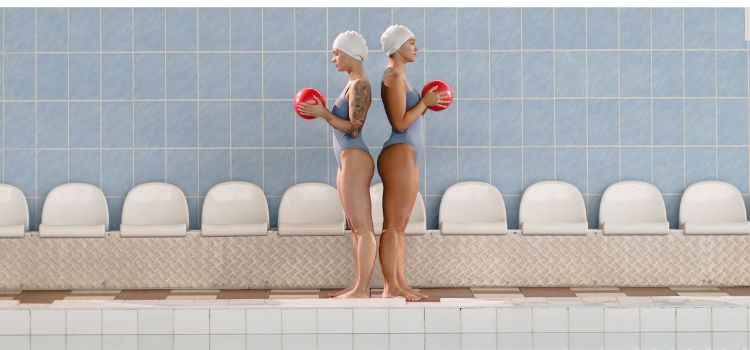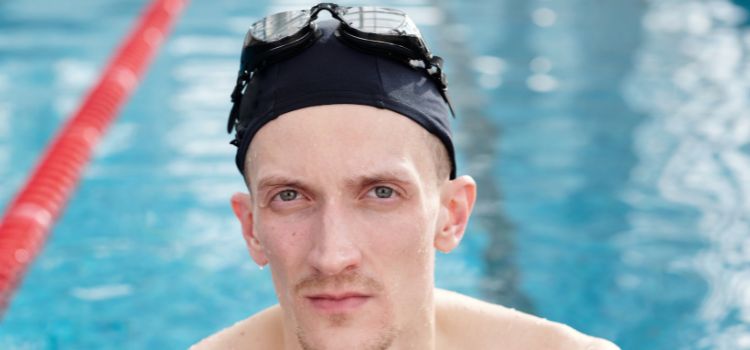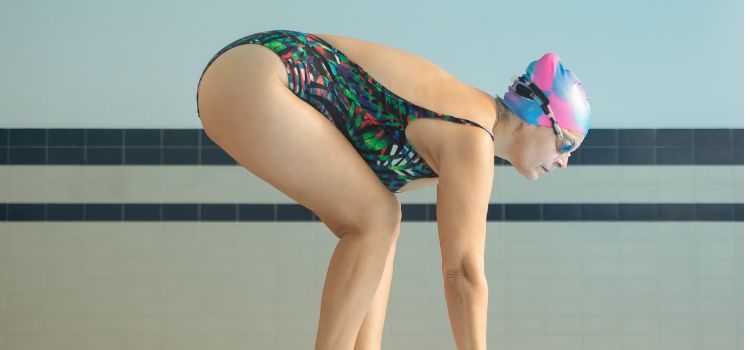As an Amazon Associate I earn from qualifying purchases.
A swim cap is more than just a piece of swim gear; it’s a vital tool for swimmers seeking hydrodynamic advantages, hair protection, and overall comfort in the water. The quest for the perfect swim cap encompasses a careful consideration of design, materials, and innovation. In this article we will delve into the intricacies of creating the ideal swim cap, examining factors such as design elements, material selection, and recent innovations that make the perfect swim cap a reality.

Design Elements of the Perfect Swim Cap
Fit and Comfort: The ideal swim cap should fit snugly yet comfortably on the head. A well-fitting cap ensures minimal drag and prevents water from seeping in, which can slow down swimmers and disrupt their focus. The design of the cap should consider head shape, hair volume, and varying head sizes to accommodate all users. The cap should also be easy to put on and take off, without pulling or snagging hair.
Hydrodynamics: Swim caps play a crucial role in minimizing hydrodynamic resistance. The design should streamline the head and minimize any wrinkles or folds, which can cause water turbulence. A smooth surface reduces drag and allows swimmers to glide through the water more efficiently. The shape of the cap should consider the forehead and ears, ensuring a smooth transition from cap to skin to maintain a low profile.
Ear Coverage: Swimmers often debate whether a swim cap should fully cover the ears or not. While it comes down to personal preference, the ideal swim cap should offer options for both. Some swimmers prefer full ear coverage for extra warmth and protection, while others prefer ear cutouts for improved hearing and comfort. Designing a swim cap with detachable or customizable ear sections can cater to various swimmer preferences.
Durability: The perfect swim cap should be durable enough to withstand regular use and exposure to chlorine and saltwater. Quality materials and reinforced seams are essential to prevent tearing or stretching. Durability can be improved by considering the thickness of the cap and reinforcing high-stress areas, such as the edges.
Material Selection for the Perfect Swim Cap

Latex: Latex has long been a popular material for swim caps due to its excellent elasticity and hydrodynamic properties. It offers a snug fit, reduces water resistance, and is cost-effective. However, latex swim caps can be less durable and may cause allergic reactions in some users. The perfect swim cap could incorporate latex with additional features to address these concerns, such as added reinforcement in high-stress areas and a hypoallergenic coating.
Silicone: Silicone swim caps are renowned for their durability and comfortable fit. They are less likely to cause allergic reactions and are resistant to tearing and stretching. However, silicone caps can be slightly thicker and provide a bit more buoyancy, which may not be preferred by competitive swimmers looking for minimal drag. A perfect swim cap could offer the best of both worlds by incorporating silicone with an optimized thickness and design for reduced drag.
Neoprene: Neoprene swim caps are ideal for open water swimmers and those braving cold waters. These caps provide superior insulation, offering thermal protection in colder environments. The ideal swim cap could incorporate neoprene alongside other materials to create a versatile cap suitable for various swimming conditions, ensuring both warmth and hydrodynamic advantages.
Eco-Friendly Materials: In the age of environmental consciousness, the perfect swim cap should consider eco-friendly materials. Recycled plastics and biodegradable materials can be used to create swim caps with minimal environmental impact. Innovations in sustainable materials and manufacturing processes are essential for the swim cap of the future.
Recent Innovations in Swim Cap Design
3D Printing: 3D printing technology has revolutionized the way swim caps can be designed and produced. This innovation allows for highly customized swim caps that precisely fit an individual’s head shape. Swimmers can have caps designed based on 3D scans of their heads, ensuring the perfect fit and minimal drag. 3D printing also enables intricate design elements that were previously challenging to achieve with traditional manufacturing methods.
Hydrophobic Coatings: To enhance the hydrodynamics of swim caps, hydrophobic coatings have been used. By repelling water, these coatings lessen drag and surface tension. A swim cap with a hydrophobic coating can help swimmers glide through the water with less effort. This innovation is particularly valuable in competitive swimming, where milliseconds can make a difference.
Temperature-Regulating Materials: Some advanced swim cap designs incorporate materials that respond to changes in water temperature. These materials can adapt to provide additional insulation in colder water and enhanced breathability in warmer conditions. Temperature-regulating swim caps ensure swimmers stay comfortable and perform at their best, regardless of water temperature.
Smart Swim Caps: The integration of technology into swim gear has led to the development of smart swim caps. These caps can track and provide real-time data on a swimmer’s performance, including metrics like stroke rate, distance covered and even heart rate. Smart swim caps connect to mobile apps, allowing swimmers to analyze their data and make performance improvements.
Swim cap making procedure

Supplies and Machinery:
1. Material Selection: Decide on the swim cap’s composition. Silicone and latex are popular choices. Make sure everything complies with safety regulations and quality standards.
2. Dye and Pigment: These are necessary to provide a range of colors.
3. Molds: Make molds or patterns to shape the swim caps. These molds must be made to accommodate different head shapes and sizes.
4. Cutting and Sewing Supplies: If your swim hat design calls for several sections, you might require cutting and sewing supplies.
Procedure:
1. Material Preparation: As per your requirement, you have to prepare the materials by cutting in into heets or strips. Make sure that is error-free and clean.
2. Setting Up the Mold: Position the mold onto a firm surface. Use a releasing agent to lubricate it so that the cap won’t adhere to the mold.
3. Material Placement: Make sure the material completely covers the mold by laying it over it. Put the pieces of the cap together if it has more than one.
4. Molding: For making the material soften and take on the shape of the mold apply accurate heat treatment to the material properly. The material and design will determine the temperature and length of time.
5. Cooling: Let the material cool on the mold when it has assumed the appropriate shape. This cooling process forms the shape of the cap.
6. Cutting and Sewing (if applicable): If your design calls for several pieces, make sure they fit securely by cutting and sewing them together with care.
7. Trimming and Quality Control: Trim any extra material to make sure the margins of the cap are uniformly smooth. Examine the caps for flaws like rips or asymmetry.
8. Coloring (if applicable): If your swim caps are colored, use dyes or pigments to give them the correct pattern and hue.
9. Customization (if applicable): If you offer customization, including names, logos, or designs at the request of the client.
10. Quality Assurance: Make sure the swim caps satisfy your safety and quality requirements by doing a last-minute inspection.
11. Packaging: Make sure the swim caps are packed properly to keep them clean and unharmed throughout storage and transportation.
Conclusion
The perfect swim cap is a harmonious blend of design, materials, and innovation. It considers factors such as fit and comfort, hydrodynamics, ear coverage, and durability to cater to a wide range of swimmer preferences. The performance and lifetime of a cap are significantly influenced by the choice of materials, including but not limited to eco-friendly, silicone, neoprene, and latex.
Swim caps are now more practical and customizable than ever thanks to recent design advancements including 3D printing, hydrophobic coatings, temperature-regulating materials, and smart features. These developments allow swimmers to train in a pool or brave the elements in open water with enhanced comfort and performance.
The pursuit of the perfect swim cap continues to evolve as technology and materials advance. As we move forward, it’s essential to consider not only performance and comfort but also the environmental impact of swim cap production. The swim cap of the future will likely be a sustainable, high-tech marvel that caters to the unique needs and preferences of every swimmer, enhancing their aquatic experience and pushing the boundaries of human performance in the water.
Amazon and the Amazon logo are trademarks of Amazon.com, Inc, or its affiliates.
Leave a Reply